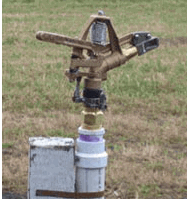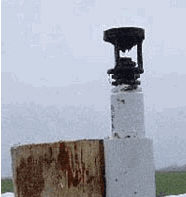



Surface Irrigation Systems for Treating Milk House Wastewater
By Kevin A. Janni, Professor and Extension Engineer, University of Minnesota, Dairy Extension. Surface irrigation was one of four types of milk house wastewater treatment systems designed, installed and monitored on Minnesota dairy farms as part of two EPA 319 Grant funded projects administered through the Minnesota Pollution Control Agency (MPCA).The effort, which began in 2002, required significant funding and collaboration by other federal, state and local agencies and the cooperating dairy producers.
Surface irrigation systems distribute milk house wastewater at agronomic rates onto cropland or pasture. Irrigation systems require large areas with minimum erosion potential. The cropland has to be relatively flat because there are times when there is minimal ground cover. Well vegetated pastures can have slopes up to 15%.
Irrigation systems include one or more septic tanks for primary treatment. The septic tanks remove grit, dirt, other solids, some organic matter and milk fat. Systems also include a dosing tank, pump, piping, control valves and irrigation heads.
The irrigation area is sized according to the annual nutrient content (nitrogen or phosphorus) of the milk house wastewater, the crop grown and the erosion potential of the application site. If the site has a slope 15% or less and is used for cropland or pasture, the application rate is based on nitrogen and requires between 100 and 350 square feet per cow depending on crop and yield. If the application site has potential for soil erosion, the application rate is based on phosphorus uptake and requires more than 2000 square feet per cow depending on crop and yield. While the irrigation areas can be quite large, it should be noted that the cropland and pasture are kept in production. Actual irrigation area needs are site specific.
Surface irrigation systems apply milk house wastewater every day. The systems are designed to apply approximately 0.01 to 0.04 inches per day.
 |
| Impact head used for summer. |
Surface irrigation systems have two or more irrigation areas or zones. Multiple zones allow the areas to dry during times when an area is being tilled, planted, harvested or grazed. Most systems have separate summer and winter zones.
Summer zones typically use traditional impact heads. In some cases the impact heads were mounted on posts along a fence line. The heads were mounted at a height to allow irrigation throughout a crop’s growing season. Experience to date suggests that there is no damage to corn or pasture irrigated daily with milk house wastewater. Alfalfa was found to be less tolerant to wet soils.
Winter zones are typically placed on pasture land. Special irrigation heads (Wobblers™) are used for winter application during below freezing weather. These heads distribute wastewater in a 50-foot diameter around the head. To be able to irrigate in below freezing weather it is critical that the distribution pipe drain back to the pump tank completely after each application. All distribution lines should be installed with a 1% or more slope. During five years of research, there were no issues with irrigation systems freezing during below zero (degrees F) weather for several weeks in a row.
Control valves are used to control which zone is being irrigated. They are typically buried in the ground with access through a maintenance hole that is insulated. The maintenance holes should be backfilled with rock or gravel to prevent rodents from burrowing into the access pipe and covering the valves with soil.
 |
| Wobblers™ irrigation head used for winter. |
The septic tanks, which provide primary treatment, are sized to hold at least three days worth of milk house wastewater. The septic tanks require emptying once per year to remove accumulating solids and fats; the effluent is land applied to cropland.
The irrigation systems installed were effective but they can be an odor source during and shortly after application. Consider prevailing winds when siting irrigation areas. A timer can control application time and odor events.
Irrigation system costs, which were site specific, ranged from $6,000 to $10,000. Annual operating costs were estimated to be $150 per year, which included the costs for emptying the septic tanks and running the irrigation pump.



